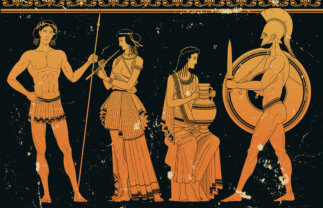
Greek Mythology and Archaeological Remains
Friday 30 December 2022
Every civilization has created a belief system to make sense of people’s shared experiences. Greek mythology explained where the world came from, and why good and bad fortune befalls us. It made sense of our passions, emotions, alliances, and feuds. It also provided society with the structures provided by rituals and a moral code.
In addition, the gods, and their stories, with all their kindness, conflict, and scheming, also reflected the lives of ordinary people, their rulers, and their wars.
Let us take a simplified look at that mythology, starting with the creation of the world, moving through the Battle of the Titans, and then talking about the twelve gods of Mount Olympus. We finish with just two examples of the vast array of mythological stories which have captivated people for centuries.
The Greek Creation Myth
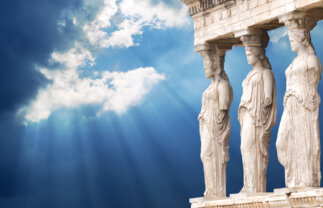
Prior to the existence of the Earth, existed Chaos. Chaos was the Primordial Goddess of infinite space, air, and mists. From Chaos were born Gaia (Mother Earth), Eros (Life Force), Tartarus (Underworld) and other gods. From Gaia was born Uranus, Father God of the Sky.
Gaia and Uranus had twelve children, the Titans. Gaia also gave birth to monsters, including the one-eyed Cyclops.
The Titan Kronos attacked Uranus and cut off his genitals, throwing them into the sea. Aphrodite the God of Beauty, Lust and Love was created from the blood. Kronos and Rhea ruled the world during the peaceful Golden Age of the Titans.
Kronos and Rhea had three boys (Zeus, Hades, and Poseidon) and three girls (Hera, Demeter, and Hestia). The boys would come to overthrow the Titans.
So, the Primordial Gods (Chaos, Gaia, Uranus, and Eros) were followed by the Titans, ruled by Kronos and Rhea. Kronus and Rhea had six children, from which come the Olympian Gods would arise in overthrowing the Titans, led by Zeus.
Battle of the Titans
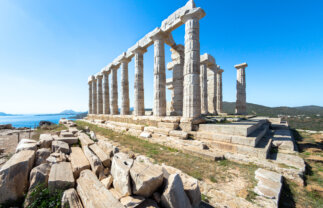
Kronos feared that he would be overthrown by his children, as was prophesized, and he ate them. But Rhea gave Kronos a rock to eat instead of the last child Zeus. Eventually all six children were freed. Zeus, Hades, and Poseidon entered into a great ten-year war with the Titans. This Battle of the Titans ended in defeat for the Titans.
Zeus became God of the Sky, and king of the gods. Poseidon became God of the Seas. Hades became God of the Underworld. Mount Olympus became Zeus’s throne, and the mountain became the home of the Gods.
Zeus married his sister Hera, who became the queen of the gods. They had three children together, though Zeus also had children with Titans, children of the Titans, his other sister Demeter, and a human woman.
The Titan Atlas was condemned to hold up the sky for all time. The Titan Prometheus did not take part in the war and was spared – more on Prometheus later.
The Twelve Gods of Olympus
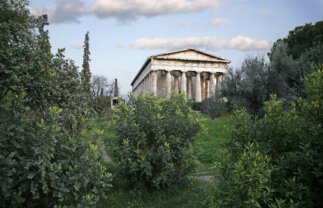
Although there are scores of Greek gods, particular honour and status is bestowed on the Twelve Gods of Mount Olympus. Many Greece Walking Tours centre around Mount Olympus and include visits to archaeological sites. Let us look at these Olympian Gods and see where they originate from and what each god represented for the lives of the people who worshiped them.
First, five of the Olympians were children of the Kronos and Rhea, the Titan rulers. The sixth child, Hades. had his own domain as God of the Underworld.
- Zeus, God of the Sky, and God of Lightning was the king and leader. In central Athens today, travellers on archaeological tours of Greece can see the remains of the Columns of the Olympian Zeus that bear testimony to a magnificent temple built to honour Him.
- Hera, Goddess of Marriage, and Faithfulness, was Zeus’s wife. The Temple of Hera at Olympia in southern Greece, was dedicated to her.
- Poseidon, God the Seas, was known for his trident. Sailors prayed to Poseidon for safe passage. The Temple of Poseidon at Sounion is in a stunning location overlooking the sea.
- Demeter, Goddess of Agriculture, Grain, and Bread. The people of ancient Greece prayed to Demeter and left gifts for her to help with their harvest.
- Hestia was Goddess of the Hearth and Home. The Statue of Hestia is housed at the Torlonia Museum in Rome.
Second, we have the goddess born from the blood of Uranus (father of the Titans):
- Aphrodite, Goddess of Love, Beauty, and Lust.
Next, we have two of the three children of Zeus and Hera. (The youngest daughter Hebe became a watercarrier for the Olympians.)
- Hephaestus was a blacksmith and the God of Metallurgy. He was known for his ugliness and was married to Aphrodite. He tried to win her love by fashioning beautiful jewellery for her. However, her passion was for his wilder brother Ares. The Temple of Hephaestus in Athens is superbly preserved and gives a wonderful insight into the craft and artistry of the times.
- Ares was the God of Violence and War. He was a hot-headed, aggressive god, and was not fondly loved by the other gods. Ares gained dedication among the warring city-state of Sparta on the Peloponnese Peninsular. The ruins of the Temple of Ares in the ancient marketplace (or ‘Agora’) of Athens are a testament to the Spartan’s veneration of this god.
Lastly, we have Zeus’s other children.
Artemis and Apollo were twins born of Leto, a child of the Titans. Leto was banished from Greece, but she found sanctuary on the small island of Delos, where she gave birth to Artemis and Apollo. This island contains fabulous remains dedicated to Apollo and Artemis.
- Apollo is the God of the Sun and of Medicine. Temples to Apollo exist on the islands of Naxos and Delos. There are also remains of healing centres dedicated to Apollo, as on the Island of Crete.
- Athena was the Goddess of Military Strategy and Wisdom. She was the patron and protector of the city-state of Athens. The Temple of Athena Nike on the Acropolis, is dedicated to her and to victory (‘Nike’).
- Artemis is the Goddess of the Hunt and Virgin Goddess of Childbirth. The ancient Greeks venerated Artemis and it is thought by some scholars that the cult of Artemis was a precursor to the worship of the Virgin Mary in Christianity. In 2017, archaeologists unearthed an ancient sanctuary dedicated to Artemis on the island of Evia.
- Hermes, the Messenger God, was known as having a winged staff.
- Dionysus, God of Wine, and Pleasure, was a demigod, but was only in later years seen as an Olympian god as a result of his popularity.
The stories of the Greek myths have intrigued people for centuries. When you go on Greece cultural escorted holidays, you will find that numerous museums display wonderful examples of painted mythical scenes on pottery of the times. Within the stories we can see the personification of issues and dilemmas faced by people of ancient Greece. Artists of antiquity represented the stories and characters of these myths beautifully on ceramics and in mosaics. We provide two of these stories below.
The Twelve Labours of Heracles (Hercules)
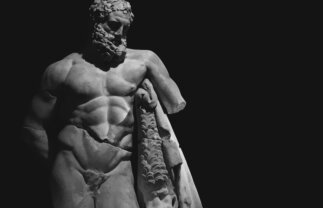
Zeus fathered his son Heracles with a human woman. Zeus’s wife was furious. Using a spell, she made Heracles kill his own children. To atone for this, Heracles worked for King Eurystheus for twelve years. King Eurystheus was unkind to Heracles and made him complete twelve seemingly impossible tasks. However, Heracles, through his strength and heroism, completed all the tasks.
Each of the ‘Labours’ is a wonderful story. For example, the first task was to slay the Nemean Lion. When Heracles tried to shoot it with arrows, he discovered that the animal’s fur was impenetrable. To surprise the lion, he covered one of the entrances to the beast’s lair and then jumped on him at the other entrance and hit him with a club. Using his great strength, Heracles bravely choked the lion and defeated it.
Heracles tried to cut away the lion’s hide but could not remove it. Athena, Goddess of Military Strategy, told him to use the beast’s own claw. This worked, and Heracles arrived at King Eurystheus’s court wearing the Nemean Lion’s hide, to the astonishment of all. King Eurystheus was so frightened by Heracles’s strength and bravery that he forbade him from entering the city again.
Prometheus and Gifting Fire to Humans
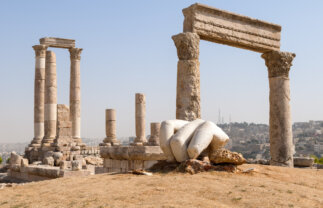
Prometheus, a Titan, did not fight in the Battle of the Gods against Zeus and his brothers. Zeus did not therefore send Prometheus to the Underworld. Instead, he was given the task of making humans from water and earth. Prometheus moulded humans from mud and made them stand on two legs like the gods. Athena then breathed life into them.
Prometheus liked spending time with the humans and over time grew fond of them.
Zeus did not want humans to possess any great powers. Prometheus, however, was intelligent and wily and he plotted a way to give humans the gift of fire so that they could cook and stay warm.
Prometheus threw a golden pear into a courtyard in Olympus. The pear carried a message saying that it was for the most desirable of the goddesses. As planned, the goddesses fought over the pear, and the gods watched with amusement. Prometheus took his opportunity, went to Hephaestus’ workshop, and placed fire from the furnace into a hollow reed. He took the fire and gifted to the humans.
When Zeus found out that Prometheus had tricked him, he was furious. He got Hephaestus to forge shackless and to chain Prometheus him to a rock. Zeus then sent an eagle to eat at Prometheus’s liver. After each day, the liver grew back, and the eagle would return to eat his liver again.